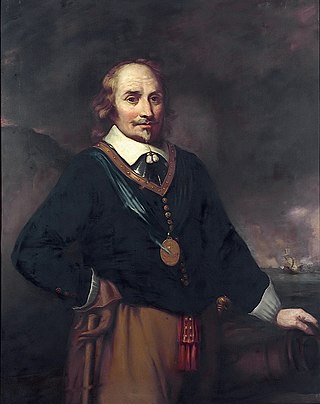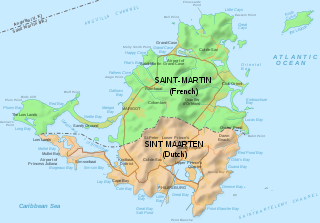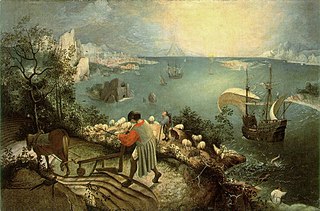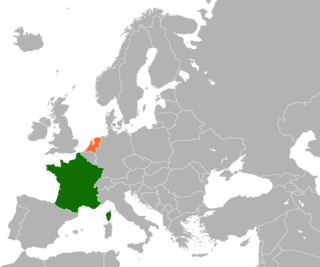
The Netherlands Antilles was a constituent country of the Kingdom of the Netherlands. The country consisted of several island territories located in the Caribbean Sea. The islands were also informally known as the Dutch Antilles. The country came into being in 1954 as the autonomous successor of the Dutch colony of Curaçao and Dependencies. The Antilles were dissolved in 2010. The Dutch colony of Surinam, although relatively close by on the continent of South America, did not become part of the Netherlands Antilles but became a separate autonomous country in 1954. All the island territories that belonged to the Netherlands Antilles remain part of the kingdom today, although the legal status of each differs. As a group they are still commonly called the Dutch Caribbean, regardless of their legal status. People from this former territory continue to be called Antilleans in the Netherlands.

Maarten Harpertszoon Tromp or Maarten van Tromp was an army general and admiral in the Dutch navy during much of the Eighty Years' War and throughout the First Anglo-Dutch War. Son of a ship's captain, Tromp spent much of his childhood at sea, during which time he was captured by pirates and enslaved by Barbary corsairs. In adult life, he became a renowned ship captain and naval commander, successfully leading Dutch forces fighting for independence in the Eighty Years' War, and then against England in the First Anglo-Dutch War, proving an innovative tactician and enabling the newly independent Dutch nation to become a major sea power. He was killed in battle by a sharpshooter from an English ship. Several ships of the Royal Netherlands Navy have carried the name HNLMS Tromp after him and/or his son Cornelis, also a Dutch admiral of some renown.

Doorn is a town in the municipality of Utrechtse Heuvelrug in the central Netherlands, in the province of Utrecht.

Saint Martin is an island in the northeast Caribbean, approximately 300 km (190 mi) east of Puerto Rico. The 87-square-kilometre (34 sq mi) island is divided roughly 60:40 between the French Republic and the Kingdom of the Netherlands, but the Dutch part is more populated than the French part. The division dates to 1648. The northern French part comprises the Collectivity of Saint Martin and is an overseas collectivity of the French Republic. The southern Dutch part comprises Sint Maarten and is one of four constituent countries that form the Kingdom of the Netherlands. Even though the island is an overseas possession of two European Union member states, only the French part of the island is part of the EU.

Jeroen Aart Krabbé is a Dutch actor and film director with a successful career in both Dutch- and English-language films. He is best known to international audiences for his leading roles in the Paul Verhoeven films Soldier of Orange (1977) and The Fourth Man (1983), for playing the villain General Georgi Koskov in the James Bond film The Living Daylights (1987) and his parts in The Prince of Tides (1991), The Fugitive (1993), and Immortal Beloved (1994). His 1998 directorial debut, Left Luggage, was nominated for the Golden Bear at the 49th Berlin International Film Festival.

UTC−04:00 is an identifier for a time offset from UTC of −04:00.

Maarten Stekelenburg is a Dutch former professional footballer who played as a goalkeeper.

Dutch and Flemish Renaissance painting represents the 16th-century response to Italian Renaissance art in the Low Countries, as well as many continuities with the preceding Early Netherlandish painting. The period spans from the Antwerp Mannerists and Hieronymus Bosch at the start of the 16th century to the late Northern Mannerists such as Hendrik Goltzius and Joachim Wtewael at the end. Artists drew on both the recent innovations of Italian painting and the local traditions of the Early Netherlandish artists.

Sint Maarten is a constituent country of the Kingdom of the Netherlands in the Caribbean region of the Americas. With a population of 41,486 as of January 2019 on an area of 34 km2 (13 sq mi), it encompasses the southern 44% of the divided island of Saint Martin, while the northern 56% of the island constitutes the French overseas collectivity of Saint Martin. Sint Maarten's capital is Philipsburg. Collectively, Sint Maarten and the other Dutch islands in the Caribbean are often called the Dutch Caribbean.

The flag of Sint Maarten consists of a white triangle situated at the hoist charged with the constituent country's coat of arms, along with two horizontal bands of red and blue. Adopted in 1985 shortly after the territory was granted a coat of arms, it has been the flag of Sint Maarten since 13 June of that year. Since the dissolution of the Netherlands Antilles on 10 October 2010, it has been the sole flag used in the constituent country.

Maarten van Rossum was a military tactician of the duchy of Guelders who became field marshal in the service of Charles, Duke of Guelders. He was greatly feared outside his home country for the ruthless manner in which he waged war. In a long career, he often put his motto ""Blaken en branden is het sieraad van de oorlog" into practice. His way of waging war was quite similar to that of his Italian colleagues, the condottieri, and was characterized by guerrilla-like tactics, in which the civilian population was spared even less than was usual in his time.
The Joint Court of Justice of Aruba, Curaçao, Sint Maarten, and of Bonaire, Sint Eustatius and Saba serves the three Caribbean countries of the Kingdom of the Netherlands and the three Caribbean special municipalities of the Netherlands. The court primarily hears disputes in first instance and on appeal of these six islands, and is on the same level as similar courts in the Netherlands. Since 2012, the court has also been authorized to hear inquiry procedures originated on Curaçao, of a type that would be heard in the Netherlands by the Enterprise Chamber in Amsterdam.

The Kingdom of the Netherlands, commonly known simply as the Netherlands, is a sovereign state consisting of a collection of constituent territories united under the monarch of the Netherlands, who functions as head of state. The realm is not a federation; it is a unitary monarchy with its largest subdivision, the eponymous Netherlands, predominantly located in Northwestern Europe and with several smaller island territories located in the Caribbean.

The Prince-Bishopric of Verden was an ecclesiastical principality of the Holy Roman Empire that was located in what is today the state of Lower Saxony in Germany. Verden had been a diocese of the Catholic Church since the middle of the 8th century. The state was disestablished in 1648. The territory was managed by secular lords on behalf of the Bishop of Verden. As a Prince-Bishopric of the Empire, the territory of the state was not identical with that of the bishopric, but was located within its boundaries and made up about a quarter of the diocesan area. By the terms of the Peace of Westphalia, the Prince-Bishopric was disestablished and a new entity was established, the Duchies of Bremen and Verden.

Quartier-d'Orleans is a seaside village on the eastern coast of the island of Saint Martin, on the French side of the Antilles. Lower Prince's Quarter, the largest town on the Dutch side of the island is located 3.5 kilometers south on the N7 road, and Grand Case, the largest beach town on the French side is 6.1 kilometers north of the Quarter on the N7 road. The N7 road continues to Marigot, the French capital on the western coast.

The siege of Venlo of 1586, also known as the Capture of Venlo, was a Spanish victory that took place on June 28, 1586, at the city of Venlo, in the southeastern of Low Countries, near the German border, between the Spanish forces commanded by Governor-General Don Alexander Farnese, Prince of Parma, and the Dutch garrison of Venlo, supported by relief troops under Maarten Schenck van Nydeggen and Sir Roger Williams, during the Eighty Years' War and the Anglo-Spanish War (1585–1604). After two failed attempts to relieve the city, the siege ended on June 28, 1586, with the capitulation and the withdrawal of the Dutch garrison.

France–Netherlands relations are the interstate and bilateral relations between France and the Netherlands. The two countries notably share a border division in the Caribbean island of Saint Martin, to which the northern part of the island is a French overseas collectivity known as the Collectivity of Saint Martin, while the southern part of the island is a Dutch constituent country known as Sint Maarten. Relations between the two countries date back to the 17th and 18th centuries when a conflict led to the transformation of the Dutch Republic to the Batavian Republic and eventually the Kingdom of Holland. The two countries currently enjoy close cultural and economic relations. Both nations are members of the OECD and Organization for Security and Co-operation in Europe, as well as founding members of the European Union, NATO, and the United Nations.

The COVID-19 pandemic in Sint Maarten, also known as the coronavirus disease 2019 pandemic in Sint Maarten,was a part of the ongoing viral pandemic of coronavirus disease 2019 (COVID-19), which was confirmed to have reached the Dutch Caribbean island of Sint Maarten on 17 March 2020. By 15 June, all cases recovered. On 1 July, a new case had been discovered, which resolved on 3 July On 15 July, a 79th case was discovered.

















